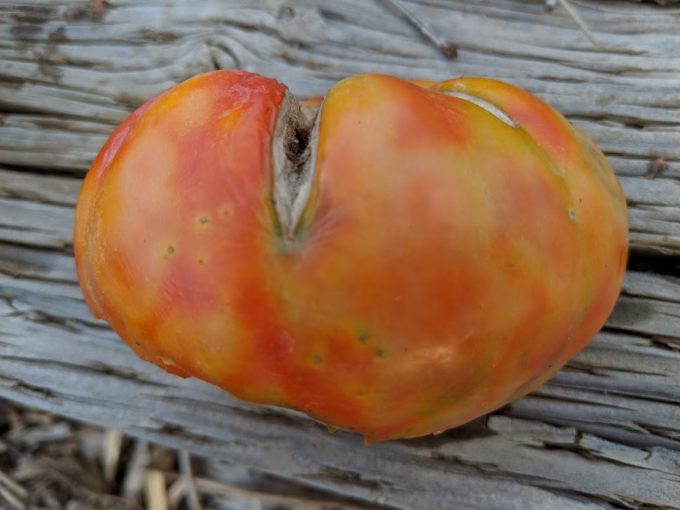I have quite the rogue’s gallery of tomato issues this year. In my own defense, I grow a lot of tomatoes. Twenty-three plants, to be exact. For a household of two. But that’s another story.
With so many plants, maybe it’s not all that surprising that I also have a variety of problems. Most of them are minor. One (as shown above) is nasty. So let’s start there, and then go through a quick check list of some other issues you might be seeing on your own plants.
Tomato Spotted Wilt Virus
This virus is sometimes referred to as TSWV for short. Like most viruses, it’s incurable. Symptoms of TSWV include dark brown to purple spots on the leaves. The spots may spread to the stems and form cankers. Eventually, the fruit begins to show obvious blotches, spots or rings.
The disease is carried by eye-strainingly (is that a word?) tiny pale insects called thrips, best seen with a magnifying glass. They suck the juice of one infected plant, then transmit the virus when they feed on another plant. Short of using floating row covers over our plants, thrips are next to impossible to control.
Plants showing symptoms of TSWV should be pulled immediately and put in the trash (never composted) to prevent further infection. Fortunately, there’s no sign of the disease on my other plants… and the infected plant is now long gone.
Catfacing
Cute name for a not-so-cute condition. Catfacing leaves puckers, holes, twists and turns in the bottom of tomatoes. It occurs when cold temperatures damage the blossom just as the fruit is beginning to set. Remember some of those chilly nights last June? Right. I’ll bet I’m not the only one along the Front Range seeing this.
The good news is that unless bacteria have found their way in through any openings in the fruit, the tomato is often quite edible once the deformities have been cut away.
Catfacing can be reduced or avoided altogether by not setting out transplants too soon, by using protection like Walls o’ Water… or by asking Mother Nature to stop playing tricks with weird late-spring weather. Oh, I forgot. This is Colorado. Never mind.
Growth Cracks
Growth cracks are often preventable, which is to say that we gardeners often cause or contribute to them.
Whether the cracks form concentric rings around the stem of the tomato or radiate downward from the stem, they occur when the plant is getting inconsistent moisture. Growth slows down a bit when the roots get drier, then speeds up when there’s a good supply of water. In effect, the fruit ends up busting its britches.
Heavy rain, which we obviously can’t control, can make the cracks worse. But we can make things worse, too, if we’re not mindful of with our watering routine.
Mulching tomatoes will help keep the root zone from drying out as quickly, but being more careful with our watering is a big factor, too. Clearly, I need to work on that.
Blossom End Rot or B.E.R.
Blossom end rot is another one of those problems that shows up when our tomato plants are getting too wet or too dry. Unusually hot or cold temperatures can also contribute.
The main symptom is a brown, leathery patch on the bottom of the tomato, the “blossom end,” opposite the stem. When a tomato’s root zone gets too dry (or occasionally, when it’s too wet for too long), the calcium in the soil gets “locked up.” It can’t properly move into the developing fruit. The tissue doesn’t form properly and B.E.R. is the result.
Once the cultural conditions are corrected, the remaining developing fruit should be okay.
The best way to prevent blossom end rot, as with T.S.W.V above, is to be careful about our watering routine. Try to maintain consistently even moisture. If the damage isn’t too deep, the unblemished part of the tomato may be edible.
Last, but definitely not least…
Stink But Damage
Some tomatoes have naturally darker colors or interesting patterns in their skin, but they’re not supposed to have freckles. A lot of my tomatoes this year have lots of freckles!
The Culprit is This Guy.
It’s a stink bug. And they zeroed in on my tomato patch this year! Linda in Dick’s Corner at Tagawa’s, says complaints about stink but damage like this have shot up in the past couple of weeks. I sympathize. These green stink bugs blend in so completely with the tomato leaves, you may never see them until it’s too late.
Stink bugs have what entomologists call a “sucking mouth part.” It pierces the skin of a plant (or a flower or lots of other garden goodies it find irresistible), feeds at will then leaves it’s calling card behind. The puncture wound eventually begins to look like the tan or black freckles I’m seeing.
I’d bet that stink bugs are such a problem this year because of our somewhat off-kilter weather this past spring. But fortunately, the pinpricks they’ve left behind on my tomatoes are quite shallow and are largely cosmetic. But they can be a serious pest cause enough damage to ruin the fruit altogether. You can bet I’ll be on the lookout for them next year. Linda and our other Garden Advisors are recommending a thorough dusting of diatomaceous earth applied before the pests get a foothold. Linda says insecticidal soap used as a contact spray also seems to work well.
As this season comes to a close, there’s always next year! I’d like to think that the longer we garden, the smarter we get. Fingers crossed!










